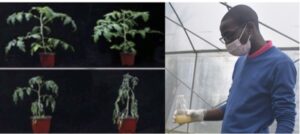Drought-induced rhizosheath may promote plant survival during soil drying
Author: Karanja J. Kibe, PhD student at Fujian Agriculture and Forestry University (FAFU)
Climate change alters many variables that may affect plant growth, with decreased soil water availability and other changes to soil conditions making it more difficult for crop plants to be productive. Better understanding of mechanisms underlying plant stress resilience may help to design future crop improvement strategies. Within the SHui project, I investigated the mechanisms of tomato acclimation to drought stress, specifically the rhizosheath trait. The rhizosheath comprises soil particles that adhere to roots during soil drying, which seems to enhance plant water availability, and crop yields.

While the plant hormone ABA is well-known to maintain root growth in drying soil, its effects on rhizosheath development were not clear. Thus my work took a multidisciplinary approach involving both morphological (root hair traits using microscopy) and molecular (transcriptomics of root gene expression) measurements. Using wild-type and ABA-deficient mutant tomatoes allowed me to establish that ABA may be an important regulator of tomato rhizosheath development in drying soil, which you can read more about here. These results offer many possibilities for future investigations, but the discoveries of novel genetic factors involved in tomato stress responses offers hope for further crop improvement efforts.
I arrived in Fuzhou from Kenya having obtained a Chinese government scholarship to start my PhD under the direction of Prof Weifeng Xu in September 2017. Although my Chinese language skills were quite rudimentary, it was a truly international laboratory with students from Pakistan so I assimilated quite readily. Just before the SHui project was awarded, Prof Ian Dodd visited the laboratory to give a seminar on his research planning for SHui, along with existing collaborations with the Fuzhou group on rhizosheath biology. This helped me focus my research planning, and reinforced the need for repeated experiments to discriminate subtle phenotypes. Besides, I collaborated with my team in setting up an additional research project investigating rhizosheath trait of white lupin under soil drying and phosphorus deficiency.
Two and a half years into my project, covid-19 emerged while I was on holiday back home in Kenya. It was quite an unprecedented phenomenon that came with travel bans and other restrictions. I had to adjust my ways of working and remotely wrote manuscripts under the guidance of my mentors. My journey was never easy but eventually it was such a rewarding undertaking that I am proud of. I successfully published my work as part of the requirement for the PhD program, and will have my thesis examined in two months’ time via a Zoom discussion with three independent reviewers.
The SHui project has allowed me to meet a diverse group of international scientists, especially when Fuzhou hosted the Chinese kickoff meeting of the project. It has provided me with many valuable learning moments, thanks to my able and committed mentors. I have gained valuable transferable skills which will help me address key questions in plant stress tolerance that are of high scientific and social relevance. My team of international scientists has been very influential in this regard, thus I greatly desire to further collaborate with them in research to enhance my future career prospects.
Further reading
- Karanja, J. K., Aslam, M. M., Qian, Z., Yankey, R., Dodd, I. C., & Xu, W. (2021). Abscisic Acid Mediates Drought-Enhanced Rhizosheath Formation in Tomato. Frontiers in Plant Science, 12, 1460.
- Aslam, M. M., Karanja, J. K., Yuan, W., Zhang, Q., Zhang, J., & Xu, W. (2021). Phosphorus uptake is associated with the rhizosheath formation of mature cluster roots in white lupin under soil drying and phosphorus deficiency. Plant Physiology and Biochemistry.

0 comments